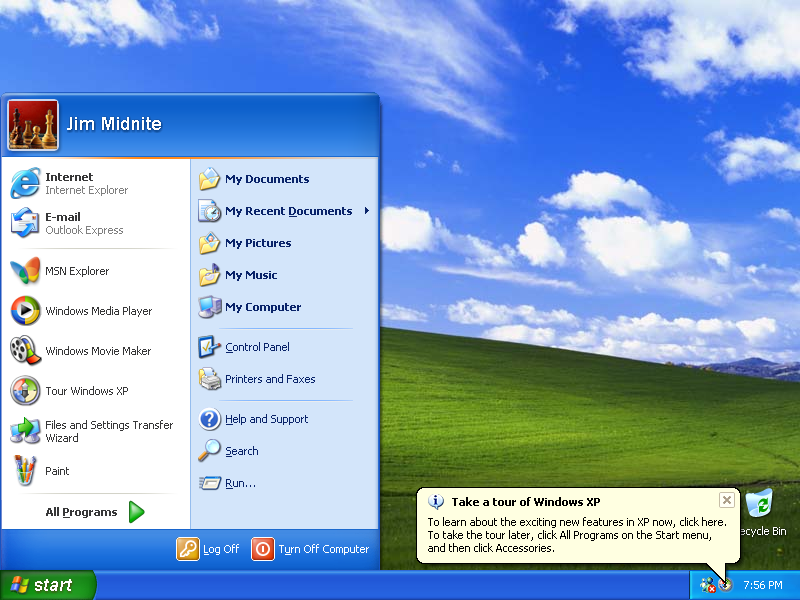

See a list of all the applications installed in your computer. See different options to shut down your computer.

Open the “File Explorer” to navigate your folders and files.Ĭhange the settings of your computer like your Internet connection or changing your background. Left PaneĪmong the things you can do in the left pane are −Ĭlick the username at the top of the menu to change account settings or log in with another user.Īccess the applications you use more frequently.Ī small arrow next to an application will open a sub-menu with a list of recent documents opened with that application.
#Windows xp start menu windows 7
The left pane resembles the traditional Start Menu from Windows 7 and earlier, while the right pane features live tiles that were used in Windows 8.
#Windows xp start menu windows 10
The Windows 10 Start Menu features two panes. Step 2 − Press the Windows key on your keyboard. Step 1 − Use your mouse to click Windows icon in the lower-left corner of the taskbar. In addition to customizing the user interface, all of the configuration changes are stored in a user profile, ensuring that every user who logs in will be able to make the Windows XP user interface as personal as he or she wants it to be.The Start Menu is the main point of access to your applications.
#Windows xp start menu how to
Here, I’ve covered how to customize the XP interface you’ll use most, the Start Menu and Taskbar. Windows XP provides you with a plethora of options with which users customize the new operating system for ease of use and personal taste. If you decide to use this option, you can clear the list of documents from the Start menu by clicking the Clear List button. This is a personal preference it’s not a default setting in Windows XP. The bottom section of the Customize Start Menu dialog box lets you select whether or not you want to display the most recently used documents. After applying the change, you can access the Control Panel options directly from the Start menu, as shown in Figure L. To make the change, you must select the As Menu option, as illustrated in Figure K. This feature helps avoid yet another window being opened on the desktop. For example, you can specify that the Control Panel open as a menu, rather than a separate window. The middle section, Show These Items On The Start Menu, offers the most customization options. To move among the different windows, you can click on a pop-up menu and select the one you want. If you consistently open many versions of the same application, such as 10 Internet Explorer windows, you can use the Group Similar Taskbar Buttons option instead of having 10 sessions on the Taskbar, you’ll have one Internet Explorer selection. The Keep The Taskbar On Top Of Other Windows option lets the Taskbar be visible at all times. Auto-Hide The Taskbar performs the same function as in other legacy Windows versions when this option is selected, the Taskbar will be hidden from view until you point to the area where it is supposed to be, making it reappear for use. When you select Lock The Taskbar, you’re preventing the Taskbar from being moved anywhere else on the screen or preventing someone from accidentally moving it off the screen. The Taskbar And Start Menu Properties dialog box has configuration tabs for the Taskbar and Start Menu. To access the configuration dialog box, right-click on the Taskbar and select Properties. You can’t please everybody, so Microsoft has included new options users can choose to configure the interface for personal preferences. The upper part of the Taskbar configuration dialog box lets you configure the Taskbar’s appearance. The Turn Off Computer option gives users the same functionality as the Shut Down option in legacy Windows versions. You won’t find anything new here other than the organization of the Start menu.įinally, the bottom of the Start menu contains the selections that you’ll use to log off or shut down the computer. The lower right section contains the Help And Support, Search, and Run options. This replaces the Settings menu found on the legacy Start menu and contains even more tools for working with your computer, such as tools for administering user accounts. Moving down the right side of the Start menu brings us to the Control Panel icon. This section also includes selections for My Computer and My Network Places.

Users will enjoy having easy access to them through the Start menu, rather than having to search their desktops for the shortcuts. On the right side of the Start menu, the top section contains links to the specialized folders My Documents, My Pictures, and My Music. This menu looks just like the legacy Start menu. As shown in Figure C, the More Programs menu lets you locate and launch the applications that are installed on the workstation. The last section on the left side is the More Programs menu.


 0 kommentar(er)
0 kommentar(er)
